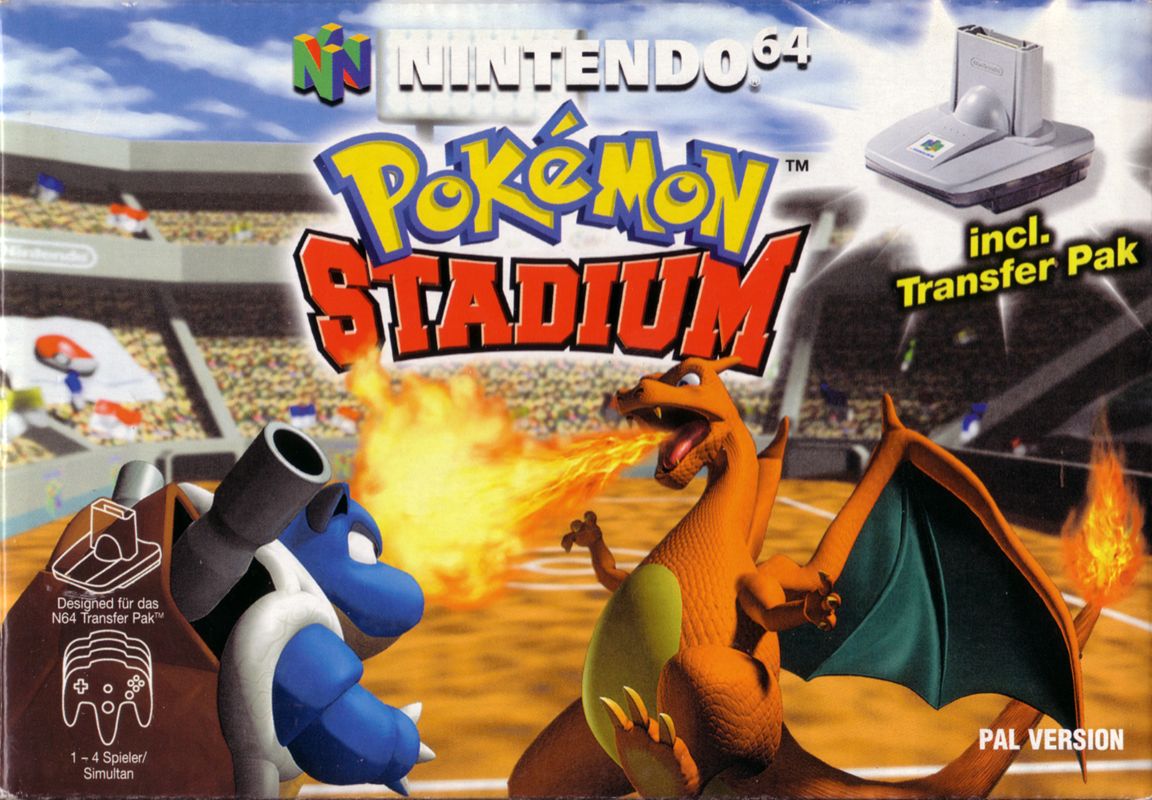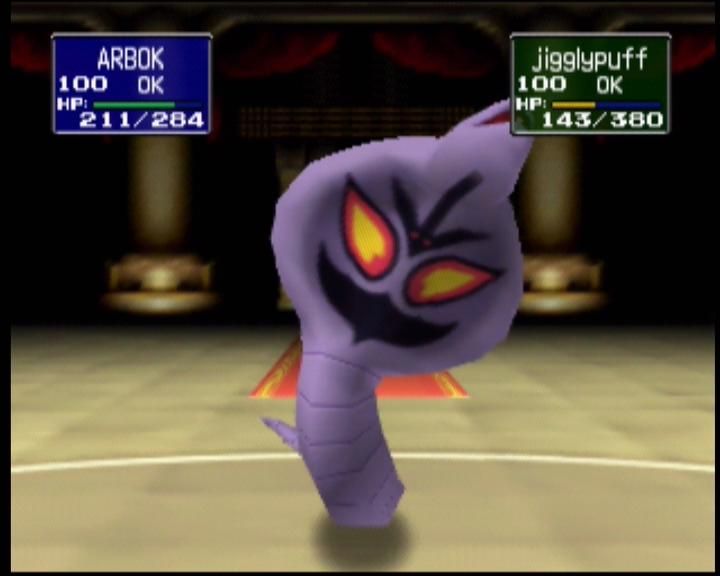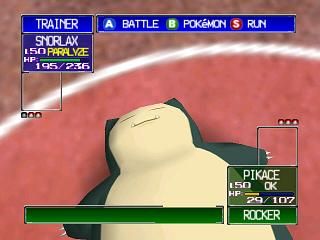Retro Replay Review
Gameplay
Pokémon Stadium transforms the handheld-style battles of the Game Boy Pokémon titles into a dynamic 3D arena on the N64, faithfully recreating the turn-based combat seen in the animated series. With all 151 original creatures available, you can assemble your dream team for one-on-one or double battles, pitting Pikachu against Charizard or testing strategies with less common Pokémon. The core combat mechanics remain true to the portable games, but the shift to a three-dimensional battlefield brings fresh tactical considerations such as camera angles, depth perception, and dramatic animations.
(HEY YOU!! We hope you enjoy! We try not to run ads. So basically, this is a very expensive hobby running this site. Please consider joining us for updates, forums, and more. Network w/ us to make some cash or friends while retro gaming, and you can win some free retro games for posting. Okay, carry on 👍)
The standout feature is the Transfer Pak integration: plug in a Game Boy cartridge of Pokémon Red, Blue, or Yellow and import your trained creatures directly into Stadium. This seamless linking means you can battle with your level-50 Charizard at full power, earn experience and items, then send everything back to your handheld. This two-way flow not only extends the life of your portable save file but also rewards dedicated trainers who invest time in leveling up their Pokémon on the go.
Beyond the main tournament mode—where you compete in Gym Leader Cup, Prime Cup, and more to earn badges, prize money, and unlock additional content—the game offers a variety of mini-games that showcase individual move mechanics. Whether you’re guiding Slowpoke nails to safety in “Poliwrath Burst” or timing your throws in “Machoke Bone Rush,” these bite-sized challenges provide delightful diversions. They also help you master move timing, which translates back into improved performance in the full-scale battles.
Multiplayer battles are a highlight, enabling head-to-head clashes using link cables and multiple controllers. Friend duels ramp up the excitement, transforming your living room into an impromptu Pokémon Coliseum. Stadium’s intuitive menus, clear command prompts, and well-paced pacing make it easy for players of all ages to jump in. Whether you’re grinding through the tournament or casually challenging friends, the gameplay loop is both approachable for newcomers and deep enough for veteran trainers seeking perfection.
Graphics
For its time, Pokémon Stadium’s visuals were a significant leap from the pixel-art sprites of the Game Boy. Each Pokémon model is rendered in full 3D, complete with signature animations for attacks like Flamethrower, Thunderbolt, and Surf. While polygon counts are modest by modern standards, the character designs retain the charm of the originals. Stadium’s arenas—ranging from grassy plains to volcanic rings—feature textured backgrounds, dynamic lighting, and environmental hazards that add flair to each bout.
Battle animations strike a balance between spectacle and clarity. Moves like Hyper Beam and Earthquake deliver satisfying impact, but they never obscure crucial battle information. Health bars, status icons, and move names appear unobtrusively at the bottom of the screen, ensuring you always know your remaining HP and applied status effects. Camera zooms and angle shifts heighten dramatic moments without causing confusion about positioning or targeting.
The mini-games also benefit from polished presentation. Bright colors, smooth transitions, and playful sound effects keep the pace brisk. From the minute details—like sweat beads on a nervous Jigglypuff—to the dramatic roars of a charging Rhydon, the audiovisual design captures the spirit of the Pokémon universe. In split-screen multiplayer, Stadium maintains performance and clarity, allowing two simultaneous battles without noticeable slowdown.
While not pushing the N64 to its absolute limits, Pokémon Stadium achieves a consistent frame rate and dependable performance. Occasional polygon pop-in is rare, and texture resolution holds up well, even on modern displays. For fans of the franchise in the late ’90s, seeing beloved pocket monsters rendered in near-full fidelity was nothing short of magical, and the visuals still hold nostalgic appeal today.
Story
Unlike narrative-driven RPG installments, Pokémon Stadium opts for a structured tournament progression rather than an overarching storyline. You assume the role of a rising trainer aiming to conquer successive cups, each governed by a lineup of CPU opponents themed around level brackets or type specialties. Earning medals in Gym Leader Cup, Round 1 Cup, and beyond acts as your narrative hook, providing a clear sense of goal and progression.
Though there’s no elaborate plot or towns to explore, the sense of momentum comes from unlocking new battle arenas, mini-games, and special challenges. Between cups, brief interstitials have you meet Professor Oak, who provides guidance and encouragement. This minimal storytelling keeps the focus squarely on the battles themselves, which for many fans is precisely the point: to pit their carefully trained Pokémon against tougher and tougher competition.
The absence of side-quests and character development might disappoint those seeking the kind of adventure found in console RPGs, but for trainers whose passion lies in cherry-picking competitive teams, Stadium’s tournament structure provides all the drama you need. Each victory unlocks more content, and the ultimate goal of filling the Pokédex trophies cabinet adds a parlor-game layer of completionism.
In essence, Pokémon Stadium offers story in the form of self-directed achievement. You craft your journey by choosing which Pokémon to level up on the Game Boy, decide which cup to tackle next, and set personal challenges—such as winning without fainted Pokémon or using only first-forms. This flexible approach to “narrative” fosters creativity and personal investment without traditional cutscenes or dialogue trees.
Overall Experience
Pokémon Stadium remains a landmark title for both Pokémon enthusiasts and N64 owners. It bridges the gap between portable and console, delivering polished 3D battles while leveraging your existing Game Boy progress. The core experience—battling in stadiums, conquering cups, mastering mini-games, and transferring rewards back to your handheld version—is finely tuned to keep players engaged for hours on end.
The replay value is substantial. Between perfecting competitive teams, exploring every mini-game, and challenging friends in local multiplayer, there’s always a reason to return. Collectors and completionists will appreciate the effort required to unlock all modes, while casual players will find instant gratification in quick matches and bite-sized challenges.
Though it lacks a deep story and features dated by today’s standards, Pokémon Stadium’s blend of accessibility and depth, coupled with its nostalgia factor, make it a must-own for fans of the franchise. Its intuitive interface, strategic gameplay, and vibrant presentation set the benchmark for Pokémon spin-offs on home consoles.
In summary, Pokémon Stadium offers a well-rounded package that honors the roots of the Pokémon series while leveraging the power of the N64. Whether you’re looking to reignite your childhood passion or simply curious about a classic piece of Pokémon history, Stadium delivers an experience that’s both approachable and richly rewarding.
 Retro Replay Retro Replay gaming reviews, news, emulation, geek stuff and more!
Retro Replay Retro Replay gaming reviews, news, emulation, geek stuff and more!









Reviews
There are no reviews yet.